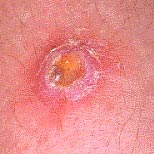Maggots, and leeches, and honey, oh my!
 In this time of MRSA (methacillin-resistant Staph aureus) skin infections, Medscape reviews 3 CAM wound treatment options.
In this time of MRSA (methacillin-resistant Staph aureus) skin infections, Medscape reviews 3 CAM wound treatment options.
Here are the highlights.
Medicinal maggot therapy
- Sterilized larvae of the green bottle fly Lucilia sericata.
- Don’t reproduce nor feed on live tissue.
- They ingest and degrade bacteria in their intestinal tract.
- Also secrete an enzyme that disinfects the wound, dissolves necrotic tissue, and stimulates wound healing.
- Approved by the FDA in 2004 as the first live organism marketed in the US.
- Reimbursable by Medicare.
Medicinal leeches (Hirudo medicinalis)
- FDA-approved as a medical device in 2004 (after maggots received clearance).
- Works by several mechanisms: inhibit blood clotting and promote local bleeding, antibiotic properties, and local anesthetic.
Medicinal honey to treat wounds
- Honey is comprised of glucose (35%), fructose (40%), sucrose (5%), and water (20%).
- Works by several mechanisms: nutrition to promote healing, kills bacteria by drawing away water (hyperosmotic), contains an enzyme that produces hydrogen peroxide (antibacterial).
- Supported by human and animal studies.
- Available as Medihoney.
Read more here about Medihoney, maggot therapy, and medicinal leeches.
A more technical review is here.
11/25/07